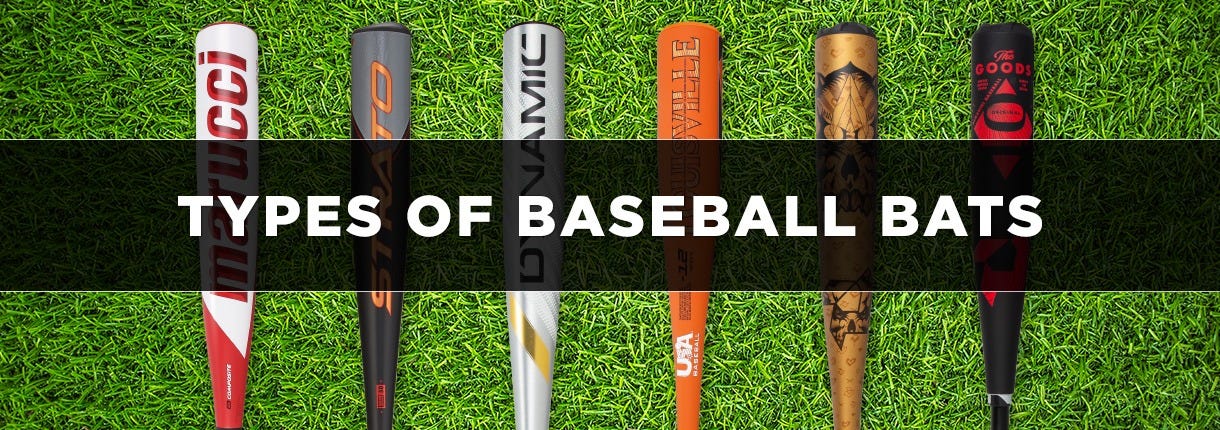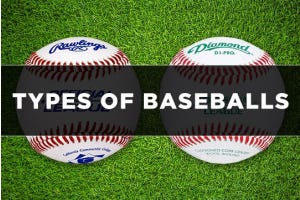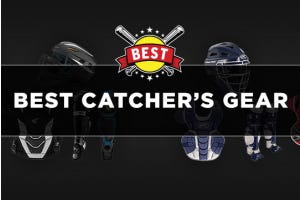A Complete Guide to the Different Types of Baseball Bats

Although baseball bats may all look the same from a distance, there are a lot of differences to consider when choosing the proper bat. Age, league, materials, and barrel shapes can all play a factor in choosing the right bat. This article is designed to walk you through the different aspects that play into choosing the right bat for yourself or your ballplayer.
In this article, we’ll cover:
As players grow and refine their skills in the batter’s box, bats will also conform. With player safety at the forefront, different bat certifications provide the player with a proper size and performance level based on age.
BBCOR bats are designed to be used by baseball players in high school and college to replicate the performance of a wood baseball bat more closely. BBCOR bats, which were first introduced in 2011, are designed to limit the trampoline effect of bats and protect the player from increasing exit velocities. All BBCOR bats will feature a -3 drop weight and will feature a 0.5 BPF (Bat Performance Factor) in order to be certified.
USA Baseball bats also feature certification standards closely related to a wood baseball bat. These bats were created for ages 5-14 as they are lighter weight and geared to help the younger player refine their batting skills. USA bats are designed in an effort to provide long-term integrity in the game and most USA Baseball bats are approved for play in USA, AABC, Babe Ruth, Cal Ripken, Dixie Youth, NABF, Pony League, and Little League.
USSSA bats cover ages 5-14 years old and must feature a 1.15 BPF or lower in order for the bat to become certified. Particular age groups of USSSA leagues and tournaments determine which bat size or drop weight should be swung. These bats were created to provide ballplayers of all ages with a properly sized bat to maximize performance and help younger players refine their skills.
Based on the player’s age, different baseball leagues will decipher what size bat and certification will be approved for play. Player safety and bat performance coincide with one another and sizing/weight differences in leagues will aid in the durability of the bat as well. If a bat is too light in weight for a particular age or league, it will be more likely to dent and be less durable.
Typically for ages 5-6, Tee Ball bats are strictly designed for the softer Tee Ball and when the ball is placed on a tee, not with live pitching. Tee Ball bats are extremely lightweight to make it easy for young kids to swing the bat and have fun learning the game.
As kids start swinging at moving baseballs, their bats also work to accommodate a change as such. Coach Pitch/Junior Big Barrel bats are typically for ages 7-8 and feature a larger barrel and light swing weight to provide the player with a greater chance to make solid contact.
Youth/Little League/Cal Ripken Bats are for ages 8-12 and are designed to aid in player performance in a number of factors. A better weight balance makes these bats easier to handle for the ballplayer. These bats being metal will also be more durable and forgiving than that of a wood bat which helps player performance.
Typically used by players ages 13-16, Senior League bats are designed to help the player transition to a BBCOR bat for high school/college. These bats have a drop weight that ranges from -5 to -13 and features a larger barrel just like that of a BBCOR bat. Players using a Senior League bat will start to feel the weight balance of the bat around this age and will start to decipher whether they prefer an end-loaded or balanced bat.
High School and College bats will all feature a BBCOR certification stamp that signifies it is legal for play. These bats were designed to more closely replicate the performance of a wood bat and aid in the transition from college to professional baseball. BBCOR bats will all feature a 2 5/8 inch barrel and will be comprised of alloy, composite, or a combination of the two.
Baseball bats are composed of different materials and sometimes a hybrid of two materials. The most common materials used in bats are alloy, composite, hybrid (mixture of composite and alloy), or wood. Different materials can play different factors in the flex or stiffness a bat might have when swinging, as well as the amount of forgiveness a barrel might have upon contact.
Composite bats can be used in all age groups but are more popular amongst Senior League players as these bats feature longer barrels and better reduce vibration in the hands than alloy bats. The majority of composite bats are two-piece, thus providing the hitter with less vibration in their hands as a rubber connection point will absorb the shock on a miss-hit. Since composite bats are typically two-piece, this will allow for more flex in the bat while swinging than a traditional one-piece bat.
While alloy bats typically feature a shorter barrel than a composite bat, an alloy bat makes up for it in its swing weight. Many baseball players in high school/college choose an alloy bat because a lighter swing weight provides them with better bat speed and that creates higher exit velocities on batted balls. Alloy bats will typically have more vibration in the hands than a two-piece composite bat but are a great option for someone who can control the bat head and has good hand-eye coordination.
Wood bats are made in both adult and youth models, which allows for most ages to swing wood bats. Wood bats are great for training hitting skills as they have a smaller sweet spot and also improve bat speed when switching back to metal. The transition from metal bats to wood is not easy, hence the reason a lot of high school and college baseball players will swing wood in the offseason.
Different baseball bats, depending on the league and age group, will have different barrel diameters. Barrel shapes can range from 2 1/4 inches in diameter to 2 3/4 inches. Barrel diameter gives the player a larger hitting surface, and a larger barrel diameter will help the player make contact more consistently. The shape of the barrel can also factor into whether the bat is balanced or end-loaded.
The swing weight of a bat is entirely player preference, however, there are benefits to both balanced and end-loaded bats. Balanced bats will aid in bat speed for a player and bat speed will equate to higher exit velocities upon making contact. Balanced bats usually have a smaller sweet spot than an end-loaded bat, thus cutting down the swing weight as well.
Unlike balanced bats, end-loaded bats will typically feature a longer barrel and provide the player with a larger sweet spot. With a larger sweet spot, a player’s bat speed will not be as great but the larger sweet spot will provide more consistent contact with fewer miss-hits.
Find the Best Selection of Baseball Bats at BaseballMonkey!
Wood bats, alloy bats, composite bats, or hybrid bats all include different features. The swing weight can be different on each bat, barrel diameter can vary depending on age and league standards, and drop weight can also be dependent on age and league standards. Luckily, BaseballMonkey has a wide variety of baseball bats for all ages so you can find the perfect bat to fit your needs!
Types of Baseball Bat FAQs
Are composite, alloy or aluminum bats better?
When comparing composite to alloy or aluminum bats, there is no difference in the performance of the bat. However, composite bats will typically feature a longer barrel and feature less vibration than alloy or aluminum bats.
What are wood bats used for?
Wood bats are great for baseball players to train with as wood bats will have a smaller sweet spot. A smaller sweet spot makes the wood bat less forgiving on mishits, thus training the player to focus on good swing mechanics.
Which type of bat has the most “pop?”
When comparing alloy or aluminum to composite bats, there is no difference in the amount of pop. These bats just feature different specs such as swing weight and the length of the sweet spot, performance will remain the same. However, wood bats will vary with the amount of pop as maple wood is harder and denser than ash or birch wood bats. This allows for more pop upon contact with the ball.
What are fungo bats?
A fungo bat is a lightweight training bat for coaches or parents to replicate in-game hits. Fungo bats are used for hitting ground balls or fly balls to baseball players at practice.






Login and Registration Form
or
Create an account